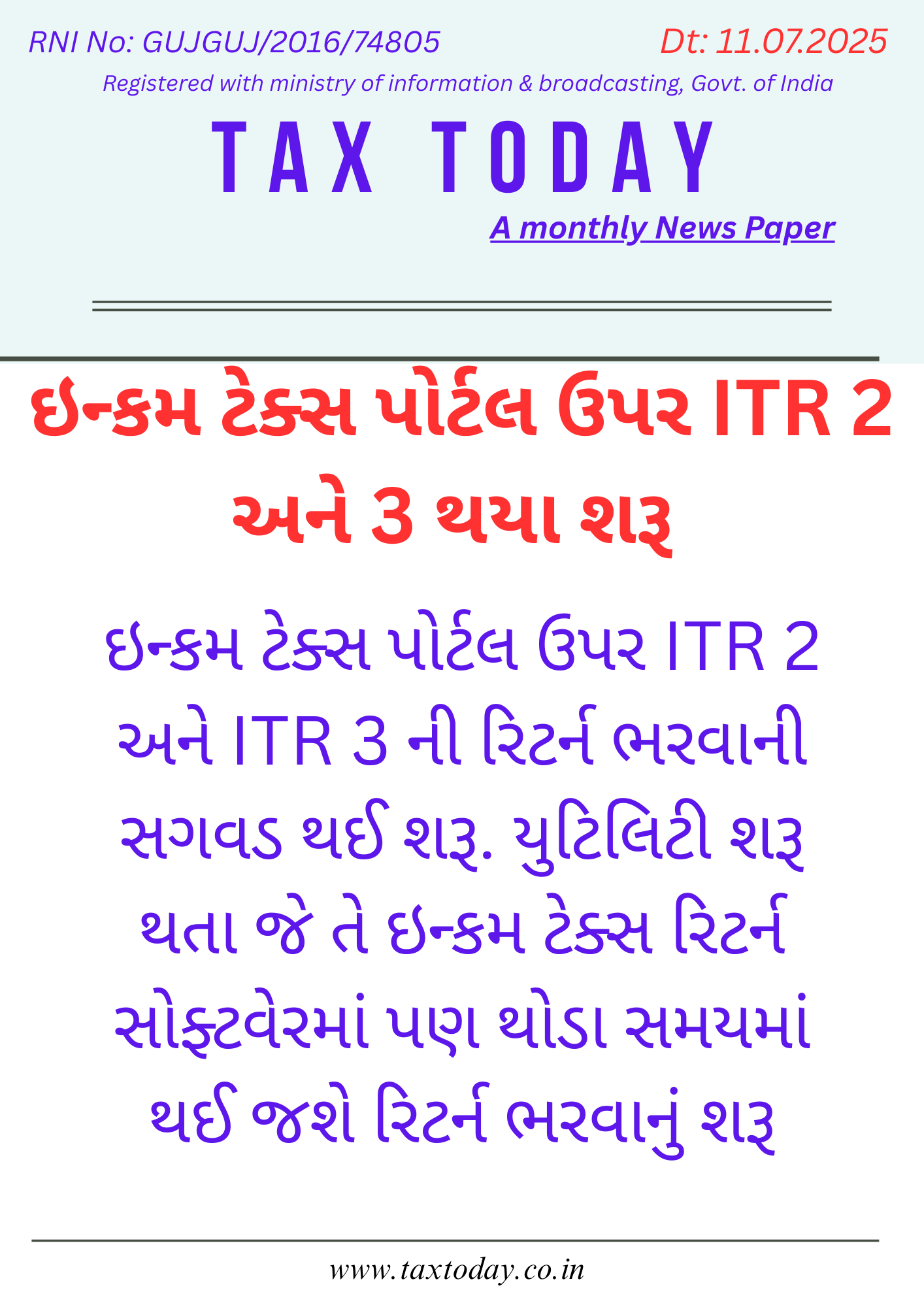GST WEEKLY UPDATE : 9/2023-24 (28.05.2023) By CA Vipul Khandhar

-By CA Vipul Khandhar
- SOP for Scrutiny of Returns for FY 2019-20 onwards(CBIC)Instruction No. 02/2023-GST dated May 26, 2023.:
Selection of returns for scrutiny and communication of the same to the field formations:
- Selection of returns for scrutiny will be done by the Directorate General of Analytics and Risk Management (DGARM) based on various risk parameters identified by them. DGARM will select the GSTINs registered with the Central Tax authorities, whose returns are to be scrutinized for a financial year, based on identified risk parameters. The details of GSTINs selected for scrutiny for a financial year will be made available by DGARM through DG Systems on the scrutiny dashboard of the concerned proper officer of Central Tax on ACES-GST application.
- The details of the risk parameters, in respect of which risk has been identified for a particular GSTIN, and the amount of tax/ discrepancy involved in respect of the concerned risk parameters (i.e. likely revenue implication), will also be shown on the scrutiny dashboard of the proper officer for their convenience. It is re-emphasized that as the data made available on the dashboard has been generated at a particular point of time for calculation of risk parameters, this data may undergo change at the time of scrutiny of returns, due to subsequent compliances carried out by the taxpayer or by the suppliers of the taxpayer. The proper officer shall, therefore, rely upon the latest available data.
Scrutiny Schedule:
- Once the details of GSTINs selected for scrutiny for a financial year are made available on the scrutiny dashboard of the concerned proper officer of Central Tax on ACES-GST application, the proper officer, with the approval of the divisional Assistant/ Deputy Commissioner, shall finalize a scrutiny schedule in the format specified in Annexure A of Instruction 02/2022- GST dated March 22, 2022. Such scrutiny schedule will specify month- wise schedule for scrutiny in respect of all the GSTINs selected for scrutiny. While preparing the scrutiny schedule, the scrutiny of the GSTINs, which appear to be riskier based on the likely higher revenue implication indicated on the dashboard, may be prioritized. The Principal Commissioner/ Commissioner of the concerned Commissionerate will monitor and ensure that the schedule identified in Scrutiny Schedule is adhered to by the officers under his jurisdiction.
- The proper officer shall conduct scrutiny of returns pertaining to minimum of 4 GSTINs per month. Scrutiny of returns of one GSTIN shall mean scrutiny of all returns pertaining to a financial year for which the said GSTIN has been selected for scrutiny.
Process of scrutiny by the Proper Officer:
- The Proper Officer shall scrutinize the returns and related particulars furnished by the registered persons to verify the correctness of the returns. Information available with the proper officer on the system in the form of various returns and statements furnished by the registered person and the data/ details made available through various sources like DGARM, ADVAIT, GSTN, E-Way Bill Portal etc. may be relied upon for this purpose.
- As mentioned in Para 3.2 above, for the convenience of proper officers, details of the risk parameters involving risk/ discrepancies in respect of the GSTIN, along with the amount of tax/ discrepancy involved in respect of the concerned risk parameters (i.e. likely revenue implication), will be made available in the scrutiny dashboard of the proper officer. Besides, DGARM will also make available to the field formations the details of all the risk parameters taken into consideration by them for the selection of GSTINs for scrutiny of returns for the particular financial year. In addition to these parameters, proper officer may also consider any other relevant parameter, as he may deem fit, for the purpose of scrutiny.
- It may be noted that at this stage, the proper officer is expected to rely upon the information available with him on records. As far as possible, scrutiny of return should have minimal interface between the proper officer and the registered person and, there should normally not be any need for seeking documents/ records from the registered persons before issuance of FORM GST ASMT-10.
- The proper officer shall issue a notice to the registered person in FORM GST ASMT-10 through the scrutiny functionality on ACES-GST application, informing him of the discrepancies noticed and seeking his explanation thereto. There may be cases where the registered person may already have made additional payment of tax, cess, interest, etc. after filing of the returns for the relevant tax period, through FORM DRC-03. The payments thus made through FORM DRC-03 may also be taken into consideration while communicating discrepancies to the taxpayer in FORM GST ASMT-10. The notice in FORM GST ASMT-10, issued by the proper officer through scrutiny functionality on ACES-GST application, shall be communicated by the system to the concerned registered person on the common portal and therefore, there will be no need for sending any manual communication of notice in FORM GST ASMT-10 by the proper officer to the registered person separately. While issuing such notice, the proper officer may, as far as possible, quantify the amount of tax, interest and any other amount payable in relation to such discrepancies. It may also be ensured that the discrepancies so communicated should, as far as possible, be specific in nature and not vague or general. In this regard, the user manual issued by DG Systems may be referred to regarding the detailed procedure for issuance of FORM GST ASMT-10 on scrutiny functionality on ACES-GST application. The proper officer shall mention the parameter-wise details of the discrepancies noticed by him in FORM GST ASMT-10 and shall also upload the worksheets and supporting document(s)/ annexures, if any.
- For each GSTIN identified for scrutiny, the proper officer is required to scrutinize all the returns pertaining to the corresponding Financial Year under consideration and a single compiled notice in FORM GST ASMT-10 may be issued to the registered person for that financial year.
- On receipt of such notice in FORM GST ASMT-10 on common portal, the registered person may accept the discrepancy mentioned in the said notice, and pay the tax, interest and any other amount arising from such discrepancy and inform the same or may furnish an explanation for the discrepancy in FORM GST ASMT-11, through the common portal, to the proper officer within the time period prescribed under rule 99 of CGST Rules.
- The reply furnished by the registered person in FORM GST ASMT-11 on the common portal shall be made available to the concerned proper officer in the scrutiny dashboard on ACES-GST application. Where the explanation furnished by the registered person or the information submitted in respect of acceptance of discrepancy and payment of dues is found to be acceptable by the proper officer, he shall conclude the proceedings by informing the registered person in FORM GST ASMT-12 through the scrutiny functionality on ACES-GST application.
- In case no satisfactory explanation is furnished by the registered person in FORM GST ASMT-11 within a period of thirty days of being informed by the proper officer or such further period as may be permitted by him or where the registered person, after accepting the discrepancies, fails to pay the tax, interest and any other amount arising from such discrepancies, the proper officer, may proceed to determine the tax and other dues under section 73 or section 74 of CGST Act. Needless to mention, for proceedings under section 73 or section 74 of CGST Act, monetary limits as specified in Circular No. 31/05/2018-GST dated February 09, 2018 shall be adhered to. The user manual issued by DG Systems may be referred to for the procedure for initiating proceedings under section 73 or 74 of the CGST Act on the scrutiny functionality on ACES-GST application.
- However, if the proper officer is of the opinion that the matter needs to be pursued further through audit or investigation to determine the correct liability of the said registered person, then he may take the approval of the jurisdictional Principal Commissioner / Commissioner through the divisional Assistant/ Deputy Commissioner, through e-file or other suitable mode, for referring the matter to the Audit Commissionerate or anti-evasion wing of the Commissionerate, as the case may be. The copy of the said approval needs to be uploaded while referring the matter to the concerned formation through the scrutiny functionality, as per the procedure detailed in the user manual issued by DG Systems.
- Timelines for scrutiny of returns:
- Scrutiny of returns is to be conducted in a time bound manner, so that the cases may be taken to their logical conclusion and that too expeditiously. In this regard, the following timelines may be observed by all concerned:
| S. no. | Process/Event | Timeline/ Frequency |
| (i) | Communication of GSTINs selected for scrutiny by DGARM on ACES GST Application for a financial year | From time to time. |
| (ii) | Finalization of scrutiny schedule with the approval of the concerned Assistant/ Deputy Commissioner | Within seven working days of receipt of the details of the concerned GSTINs on ACES- GST application |
| (iii) | Issuance of notice by the proper officer for intimating discrepancies in FORM GST ASMT-10, where required | Within the month, as mentioned in scrutiny schedule for scrutiny for the said GSTIN. |
| (iv) | Reply by the registered person in FORM GST ASMT-11 | Within a period of thirty days of being informed by the proper officer in FORM GST ASMT-10 or such further period as may be permitted by the proper officer |
| (v) | Issuance of order in FORM GST ASMT-12 for acceptance of reply furnished by the registered person, where applicable | Within thirty days from receipt of reply from the registered person in FORM GST ASMT-11 |
| (vi) | Initiation of appropriate action for determination of the tax and other dues under section 73 or section 74, in cases where no reply is furnished by the registered person | Within a period of fifteen days after completion of the period of thirty days of issuance of notice in FORM GST ASMT-10 or such further period as permitted by the proper officer |
| (vii) | Initiation of appropriate action for determination of the tax and other dues under section 73 or section 74, in cases where reply is furnished by the registered person, but the same is not found acceptable by the proper officer | Within thirty days from receipt of reply from the registered person in FORM GST ASMT- 11 |
| (viii) | Reference, if any, to the Audit Commissionerate or the anti-evasion wing of the Commissionerate for action, under section 65 or section 66 or section 67, as the case may be. | Within thirty days from receipt of reply from the registered person in FORM GST ASMT- 11 or within a period of forty-five days of issuance of FORM GST ASMT-10, in case no explanation is furnished by the registered person. |
- It may also be ensured that the requisite actions must be initiated well ahead of the time limits as specified in section 73 or section 74 of the CGST Act, as the case may be, in respect of a return identified for scrutiny for a financial year.
Reporting and Monitoring:
- The details of action taken by the proper officer in respect of GSTINs allocated to him for scrutiny will be available in the form of two MIS reports in the scrutiny dashboard on the ACES- GST application. MIS report ‘Monthly Scrutiny Progress Report’ (in the format specified in Annexure-D of Instruction No.02/2022 dated March 22, 2022) displays summary information of the status of scrutiny of returns for the selected month of a financial year for the selected formation. Besides, the GSTIN-wise details of action taken in respect of scrutiny of returns in respect of allotted GSTINs is made available in the MIS report ‘Scrutiny Register’ (in the format specified in Annexure-C of Instruction No.02/2022 dated March 22, 2022) on the scrutiny dashboard.
- In view of this, the requirement of compiling and sending the Monthly Scrutiny Progress Report by the CGST zones to DGGST is hereby dispensed with for the Financial Year 2019-20 onwards. However, the CGST zones will continue to send Monthly Scrutiny Progress Reports to DGGST in respect of the Financial Years 2017-18 and FY 2018-19 till the completion of scrutiny of returns for these financial years, as per the timelines mentioned in Instruction No.02/2022- GST dated March 22, 2022.
- It is also added that the progress of the scrutiny exercise as per the scrutiny schedule shall be monitored by the jurisdictional Principal Commissioner/ Commissioner on regular basis.
It is clarified that since the scrutiny functionality has been provided on ACES-GST application only for the Financial Year 2019-20 onwards, the procedure specified in Instruction No. 02/2022 dated March 22, 2022 shall continue to be followed for the scrutiny of returns for the financial years 2017-18 and 2018-19.
- NIC – GST Systems Process of blocking of E-way Bill and E-invoice generation to tax payers due to large number of erroneous hits
- To facilitate seamless integration with the existing ERPs or financial accounting applications, the GST E Way Bill and GST eInvoice systems of NIC are providing the services through Application Programming Interfaces (API). Using these facilities, many businesses have integrated their systems directly or through GSPs or
- NIC has also facilitated the tax payers to test the integration of their ERP systems with NIC – GST systems on testing environment, SANDBOX. It has been informed to all the tax payers to test the integration on sandbox with all types of APIs before going for the
- In spite of following of all these measures, it is being observed that many tax payers’ applications generate large number of erroneous hits to the GST E Way Bill and GST eInvoice In case of any error due to validation of data or data type or format or otherwise, appropriate error codes and error messages are provided in response to such requests by GST system. The tax payer application has to capture these error codes and facilitate to take action in correcting the issue, either in software or data and only then re-send the requests. Distinct error codes with detailed descriptions are provided in response for various types of failures, so that the tax payer application can take appropriate measures to correct the request payload. But many tax payer applications are ignoring the response error codes but continue to send the same erroneous request payloads multiple times, sometimes, lakhs of times.
- For example, when the request payload has issue with total taxable value, the following error code and description is responded Unless the values are corrected and sent, even if the same payload is sent lakhs of number of times, the same error is responded with. This is due to not handling or testing of these cases in the tax payer application.
| Error Code | Error Message |
| 2182 | Taxable value of all items is not equal to total taxable value |
- These large number of unproductive hits consume the network and server resources not only of the business entities but largely affect the GST infrastructure hosting these API services. This will directly impact the performance of the GST system and hence causes inconveniences to other users of the system across the It may result in Denial of Service (DoS) attack also.
- To bring awareness to the users on large erroneous API calls, NIC has taken several measures such as providing detailed description of the errors, the relevant help on the causes and resolutions for the errors etc. NIC has been sending the summary of errors through mails every day to the users as
- In spite of best of efforts by NIC, the issue of large number of errors exceeds unacceptable range at times and affects the performance of the whole system. The same could have been controlled through technology but there will be chances of genuine hits getting
- Hence the following process or measures are being taken to control these erroneous
- The automated mails will continue to be sent to the authorized signatory’s mail
This can be treated as the first notice.
- To start with, if the number of errors is more than 20,000 per GSTIN or more than 1 lakh for a client Id, a mail will be sent from the support / help desk team to the same mail, id intimating about the errors and 2 days’ time will be provided to correct the issue and report
- If the issue repeats more than 2-3 days continuously, the automated mail itself may be treated as the prior intimation and the access to all the API of e-way bill and e- invoice will be
If the GSTIN or the client id are blocked, following error messages will be responded with,
| Error Code | Error Description | Resolution |
|
3095 |
e-Invoice operations are temporarily disabled for the CLIENT – {0} as large number of erroneous requests have been received from the client for quite sometimes. | Pl analyse the error responses received from the portal and troubleshoot your system and rectify the issue and contact the help desk for enabling. |
|
3096 |
e-Invoice operations are temporarily disabled for this USERNAME/GSTIN –
{0} as large number of erroneous requests have been received from the USERNAME/GSTIN for quite sometimes |
Pl analyse the error responses received from the portal and troubleshoot your system and rectify the issue and contact the help desk for enabling. |
- It is the responsibility of the end user (GSTIN) as well as the service provider like GSP/ASP/ERP etc. (client id) to take care of the number of error generated on the system to avoid any inconvenience.
- Once the tax payer resolves the issue, he will communicate the same to the helpdesk, then blocking will be revoked and tax payers will be allowed to If it repeats, the blocking will not be revoked till the tax payers does the thorough testing of integration on the sandbox for 2-3 days.
- Gradually, the limit on the number of errors for GSTIN and Client Id will be
Disclaimer:
This publication contains information for general guidance only. It is not intended to address the circumstances of any particular individual or entity. Although the best of endeavour has been made to provide the provisions in a simpler and accurate form, there is no substitute to detailed research with regard to the specific situation of a particular individual or entity. We do not accept any responsibility for loss incurred by any person for acting or refraining to act as a result of any matter in this publication.





